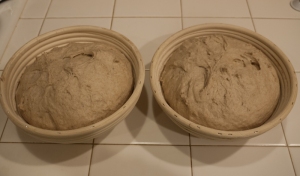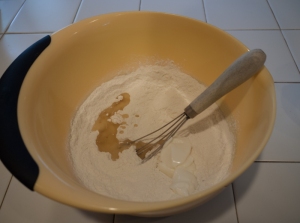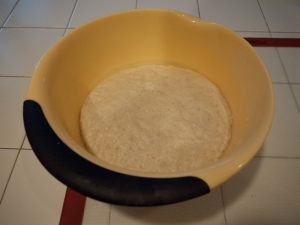My mom sometimes mails me random stuff she thinks I might find interesting, and a while ago she mailed me a Swedish flyer with some baking recipes. The flyer was publish by KF Provköket which seems to now be coop Provkök, a test kitchen for the retail cooperative coop. The flyer looks like it is published in 1985, and I could not find the recipes online.
Swedish is close to Danish, so I could easily figure out the recipes. The one that caught my eye was one for a whole grain ‘peasant bread’. It is using a scalding technique and is made with rye flour and some ground bitter orange (pomerans) rind. I find that quite a bit of Swedish bread is made with some sort of spices, and it is usually a nice touch. I did not, however, have any bitter orange rind or knew where to get it, so I decided to add some ground all-spice for some general complex spiciness, and that worked well.
Though not required by the recipe, I used the opportunity to use my bannetons again, and the breads turned out beautiful.
Ingredients:
- 500 ml boiling water (2.1 cups)
- 500 ml whole grain rye flour (2.1 cups)
- 1 tsp ground all-spice
- 50 g butter (1.8 oz)
- 250 ml water (1 cup)
- 16.6 g active dry yeast (0.6 oz) (50 g fresh yeast cake)
- 2 tsp salt
- 1100 ml bread flour (4.6 cups)
Method:
1. Mix this rye flour and all spice together in a bowl.
2. Pour boiling water over the mixture, cover with film and let stand for 2-4 hours (until a little warmer than room temperature).
3. Melt the butter and add the water. Let cool to 90 F/ 37 C.
4. Mix the yeast in the water/butter mixture.
5. Add the yeast, butter and water to the scalded flour and mix.
6. Mix the salt and gradually add almost all of the bread flour, and mix until a dough forms.
7. Knead lightly in the bowl for a few minutes.
8. Cover with film and let rise for 45-60 min.
9. Turn the dough out on a work surface and knead lightly. Add more flour if necessary.
10. Divide dough in 2 and form 2 round breads.
11. If using, dust 2 8-inch bannetons with rice flour and place the breads in them. Otherwise place breads on a parchment lined sheet.
12. Cover breads and let rest for 20-30 min.
13. Preheat oven to 200 C / 392 F.
14. Turn the breads out on a parchment lined sheet and transfer to oven.
15. Bake for 40-45 min, they are done when lightly brown and hollow sounding.
Since there is not much kneading involved, these are actually quite fast and easy to make. The scalding make it quite moist, and the spice and rye combination adds a lot of flavor. This bread is great still warm with butter, or as sandwich bread. I found it kept very well.




























